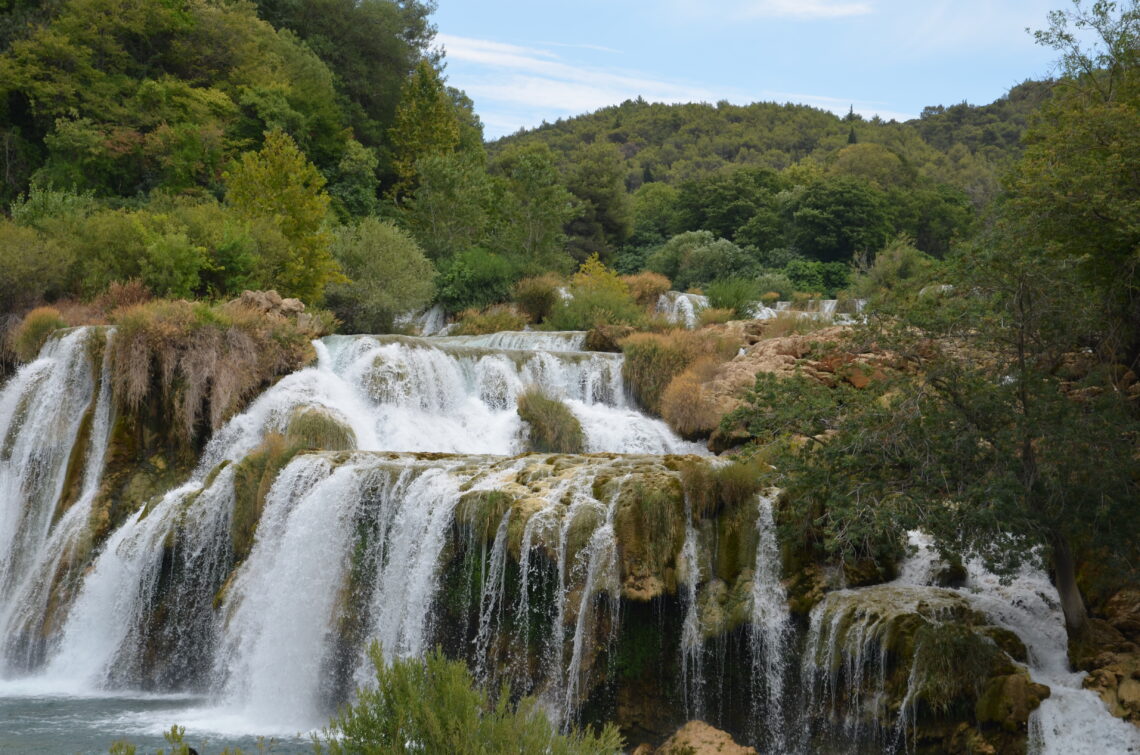
Krka National Park: Waterfalls, swimming and hiking
Krka National Park has it all: beautiful nature, hiking and swimming opportunities, architectural, historical and archeological sites. We visited the Krka National Park in Croatia on a road trip in 2017 during a hot Summer. So the swimming part was very welcoming to us.
Where is Krka National Park?
Krka National Park is in Dalmatia in Croatia. To be exact in the northern part of Dalmatia, near Lozovac and Skradin. It’s close to Šibenik. From Šibenik to Krka National Park is 15 kilometers, about 20 minutes by car. Zadar is an hour driving with 76 kilometers. Split to Krka National Park is an hour and 15 minutes for 85 kilometers. Rijeka, Zagreb and Dubrovnik are more than 3 hours driving away.
Before visiting make sure you wear the right clothes and footwear, clothes that are comfortable, but dry fast when they get wet. For shoes something comfortable like Colombia water shoes, sandals and boat shoes.

Some facts about Krka National Park
Krka National Park covers 109 km² and is managed by the Public Institute, which falls under the jurisdiction of the Ministry of Environmental and Nature Protection. The park is established on January 24th 1985. They receive over 3.5 million visitors a year, that come to see the waterfalls, abbey- and castle ruins and go on hikes and boat rides. Krka is one of the 7 national parks of Croatia.

The heart of the park is the river Krka, which has its origins at the Dinara mountains. From there it runs to the sea in about 72 kilometers, and has made a deep gorge. Almost at the end are 7 waterfalls which is the part that forms the national park. Most visitors come in the Summer months. There’s a limit of 10.000 visitors at the same time, so arrive early in July and August, because the limit is usually already reached at 10am.

Waterfalls
The Krka National Park waterfalls are the main event everyone comes for. The 7 waterfalls in the park are Skradinski Buk; Bilušića Buk; Brljan Slap; Manojlovac Slap; Rošnjak Slap; Roški Slap and Miljacka Slap. The total height of the 7 waterfalls is 242 meters. The waterfalls in the river Krka are all travertine waterfalls. Travertine is a limestone deposit that has been formed over thousands of years.

The Bilušića Buk is the first of the seven cascades in the river Krka. Manojlovac Slap is in the North of the park, and with a drop of 60 meters the highest waterfall in the river Krka.
Skradinski Buk

Skradinski Buk is the largest waterfall in the Krka National Park Croatia. This is the sight most people recognize from the national park. It’s a picture perfect waterfall with its green landscape and waterfalls that drop down in a crystal clear pond. The pond reflects the waterfalls. What makes the waterfall so imposing is its 100 meters in width and 400 meters in length. The Skradinski Buk consists of 17 travertine waterfall traps that cover a 47 meter height difference. The Skradinski Buk is the largest travertine waterfall system in Europe.

You can walk around the waterfall in an hour on an easily accessible path with bridges. You get to see the waterfall up front and the 17 traps. Although walkable in an hour, it took us some 3 hours, this includes swimming and walking in the crowds towards the swimming area. Our than 7 year old son could easily do this walk. Beyond the swimming area are stalls that sell dried fruits and nuts. Crowds were less here and for the rest of the path.

Roški Slap
The second most popular destination in the Krka National Park. Reachable with a hike, by car and with a boat. It’s a series of travertine waterfalls which has 12 traps and at the end makes a 15 meter drop in the lake Visovac.
Visovac island
In the middle of the Krka river is an island. On the drive from Lozovac towards Roški Slap there’s a perfect view on this island. The island houses a museum, a church and the Visovac abbey.
Augustinian monks founded a small abbey here in the 14th Century. Later on the 15th Century Franciscans build further on this abbey. In the 18th Century a whole new abbey was build, which contains parts of the older abbey. The abbey has an library with books and rare manuscripts. Oh. To go through these books must be wonderful. My heart always beats faster from being surrounded by books.
Swimming

Besides admiring the waterfalls everyone comes to swim near the waterfalls. Although these aren’t the only waterfalls you can go swimming near, other examples are the Kravica waterfalls in Bosnia Herzecovinia or the waterfall Sum in Slovenia, it’s still special. At the lower part of the Skradinski Buk you can go swimming in the Summer months. It’s a designated area where you can go swimming, so stick to this. When we were there we saw people go beyond the line in the water.
Bring swimming gear with you, or better yet have it already on. Yuri wore watershoes, these can be handy on the rocky underground. You can get in the water from the sandy banks. Paul and Yuri swam in the water for over an hour, and Yuri actually didn’t want to go out of the water. He had too much fun with it and it was perfect during the hot weather we had.

Sadly from January 1st 2021 swimming will be prohibited at the national park, since it’s too damaging.
Hiking and biking
The hike around Skradinski Buk is the most popular hike in the park, but far from the only one. There are 22 trails and 5 viewpoints.
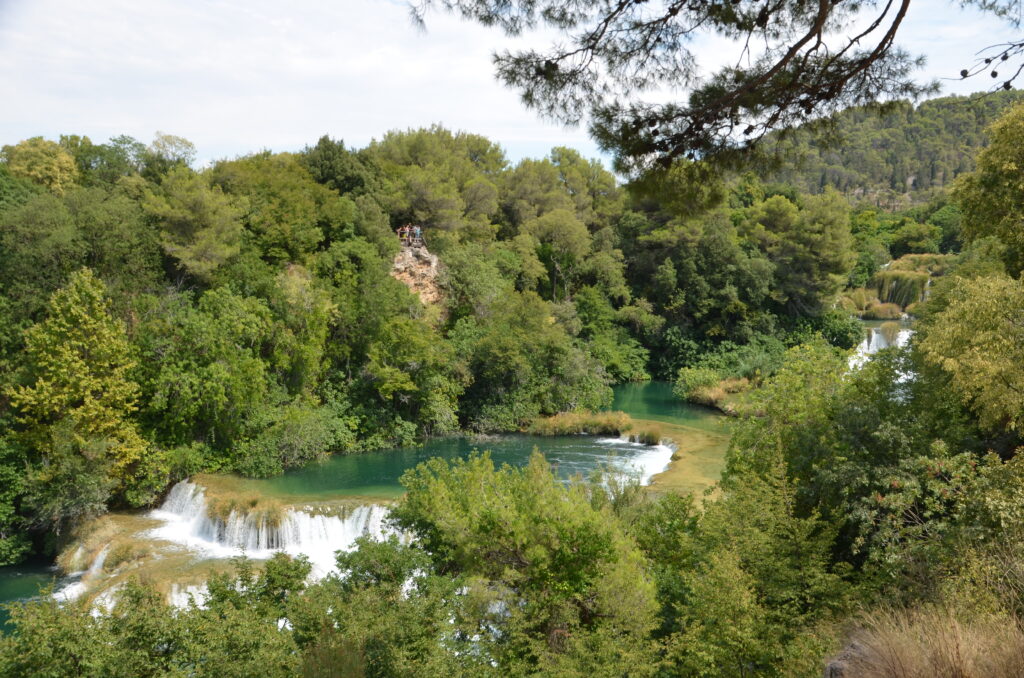
The several viewpoints:
- Krnîći Gornji viewpoint
- Čikola viewpoint
- Visovac viewpoint
- Krka monastery viewpoint
- Brljan viewpoint
There’s 470 kilometers of bike routes, 14 circular routes of which 5 MTB routes, 3 Road routes and 6 Track routes suitable for family rides.
Tours
Krka National Park offers 3 boat excursions with a guide.
- A 2 hour tour to Visovac island. This tour covers a hike on which you visit the 19th century water mills, a boat tour to Visovac island on which you visit the museum, abbey and church. (100 Kuna adults, 4-14 years 70 Kuna.)
- A 4 hour boat tour to Roški Slap. A boat tour to Visovac island with a visit to the abbey, museum and church. After that a boat tour and visit of Roški Slap. (130 Kuna adults, 90 Kuna kids 4-14.)
- A 2,5 hour tour to the Krka monastery and the early Croatian fortress of Trošenj and Nečven. (100 Kuna adults, kids 4-14 70 Kuna.)
What else is there?

Besides waterfalls the park has numerous lakes due to the many height differences, furthermore there are cliffs, swamps, mangroves and rocks. There are over 1000 different species of plants, 221 bird species, many fish and other animals. In the Summer dragonflies abound. Other interesting destinations in the Krka National Park are the 19th century water mills on the river (on the path around Skradinski Buk), the Oziđana pećina cave, the archeological site of Burnum (an old Roman camp). The park gives educational workshops for kids.

There’s a Krka app which shows you where you are in the park and provides information on all the attractions.
Entrance
There are 5 entrances to the park: Lozovac, Skradin, Roški Slap/Laškovica, Burnum/Puljane and Kistanje/Krka Monastery.
The Lozovac entrance is the main entrance and is where the biggest bulk of people enter the park. This is the entrance closest to the Visovac island. From here a path walks down towards the waterfalls, that goes through the whole park. During the Summer months busses take visitors down near to the path around Skradinski Buk. The bus ride is included in the entrance fee.

From the Skradin entrance the park offers 25 minute boat rides to Skradinski Buk. The boat is included in the entrance fee.
Krka National Park is open year round. Although not everything in the park and not every entrance is open in the winter months. Same goes for boat excursions, boat- and bus transport.

Opening hours of the park vary from month to month and from entrance to entrance, they can be found here.
Tickets
Krka National Park tickets start at 30 Kuna for adults and 20 Kuna for kids 7-18 years in January, February, March, November and December. Kids under 7 are free of charge. In April, May and October adults pay 100 Kuna and kids 7-18 80 Kuna. In June, July, August and September adults pay 200 Kuna and kids 7-18 120 Kuna. Entrance after 4pm is 150 Kuna for adults and 90 Kuna for kids 7-18 years.
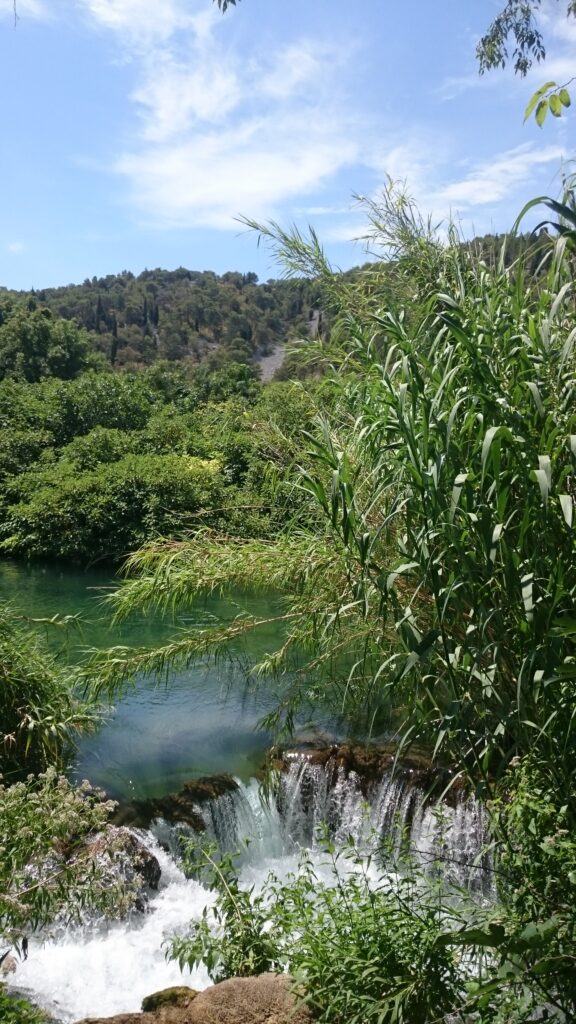
There’s a 3 visit ticket available that’s valid 7 days after purchase. In January, February, March, November and December this is 65 Kuna for adults and 45 Kuna for 7-18. April, May and October it’s 230 Kuna for adults and 180 Kuna for kids 7-18. In June, July, August and September it’s 320 Kuna for adults and 200 Kuna for kids 7-18. If only going to Roški Slap, Kistanje, Burnum or Puljane there are lower entrance fees.
Where to stay
We visited Krka National Park while staying at Beach resort Solaris, one of our all-time favorite campsites in Croatia and one of our best family campgrounds in Europe.
Where to eat
There are several restaurants in the park near the entrances. You can also bring a packaged lunch with you and enjoy this with a view on the waterfalls.

Although the Plitvice Lakes National Park takes the most visitors over Krka National Park,
don’t think you can just skip it after seeing Plitvice lakes. It’s worth its own visit.
Like it! Pin it!




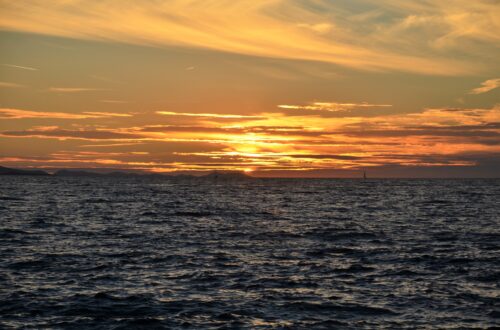
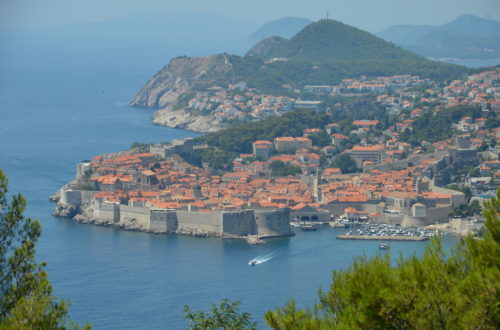
31 Comments
Alma
Beautiful area but cannot believe the amount of people swimming at Skradinski Buk!
Cosette
Yes, it was pretty crowded, back in 2017. I imagine it will have been less crowded last Summer.
Parnashree Devi
Such a great location to go for a vacation. The waterfalls look beyond fantastic. I am bookmarking it for my future travels.
Cosette
Hope you get to go to Croatia and Krka National Park in the future.
Taylor
Krka National Park looks so beautiful! I was supposed to go to Croatia this past summer for my birthday, but I’m saving it for next summer instead. Definitely keeping this article on hand. 🙂
Cosette
Oh, that’s a bummer that yopu couldn’t go to Croatia this Summer. Hope you can go next year. Croatia is really beautiful.
Shelley
OMG, this place looks even more beautiful than Plitvice! I had never even heard of it until your blog, but now I have added it to my Croatia travel itinerary.
Cosette
I think I still find Plitvice more beautiful than Krka, but Krka is definitly worth your time.
Lisa
I’ve heard so many wonderful things about Skradinski Buk in Krka National Park! Such a beautiful place to explore. It’s certainly on my bucketlist!!!
Cosette
Hope you get to go to Krka National Park in the future. Skradinski Buk is really beautiful and fun to visit.
Katie Diederichs
Such a beautiful place! We went here back in 2015 and had such a good time! Thanks for reminding me of the memories!
Cosette
Yes, it’s really beautiful. Happy I could remind you of good times.
Mateja
I have just recently visited Krka National Park and totally loved it. Impressed that you went into such a detail, great guide! And actually, I sort of liked them more than Plitvice 😉
Cosette
I think I still find Plitvice more beautiful, although Krka National Park was also really beautiful. You just have to visit both of them.
Lauren Korstrom
I’m always so curious to see what hiking is like in different parts of the world. It is all similar in some ways but so different in others. We’re so so lucky to have these epic landscapes so available to us especially that waterfall! My goodness!!
Cosette
Yes, hiking can be quite different in various parts of the world. It’s just a great way to explore nature around you. And the waterfalls in Krka National Park are simply gorgeous.
Olivia
Never knew such a beautiful natural site exists in Croatia! I’d imagine It would look especially nice during the summer 🙂
Cosette
Yes, Croatia has a lot of beautiful nature sites. Krka National Park isn’t the only one. There’s also Plitvice lakes and more.
Devin Held
Krka National Park looks so amazing to hike through! I love all the swimming spots. Pinning for later!
Cosette
It’s definitly beautiful to hike through Krka National Park, but sadly you can’t go swimming anymore from 2021 on.
Kelly
Krka looks so beautiful! This park will definitely be on my list whenever I can visit Croatia 🙂 This makes me want to go so badly and hopefully I can in the next few years!
Cosette
Hope you get to go to Croatia in the next few years. There’s so much to discover.
Liza
Wow! Looks amazing! Thanks for all the information. I hope to be able to go one day!
Cosette
Hope you get to go someday to Krka National Park.
Jeff Albom
I have seen some of these waterfalls in photos but I never understood the layout and range of all the falls together. It is magnificent. Swimming at Skradinski Buk in the summer looks fabulous.
Cosette
Yes, the swimming was fantastic.
Rob + Ann @TravelLatte
Wow, what a fantastic National Park! Love all of the waterfalls, and it looks like a great place to cool off with a swim during the summer. Adding to our “to do” list, for sure!
Cosette
Yes, but sadly the swimming is prohibited as of this year.
Elyse
omg looks so amazing here. Thanks for sharing all this helpful info
Josy A
Krka National Park looks sooo fun! It may be crowded, but I love that there are so many people swimming and enjoying the water near the waterfalls, rather than just looking at them from afar.
Laureen Lund
How did I miss this when I was in Croatia? You are right…we did go to Plitvice, wish I had known about thhis beautiful spot. We will definitely be back to Croatia and when we do we will visit this waterfall and park.